Classic French Steak Au Poivre
This post may contain affiliate links. Read my full disclosure policy.
Master the art of steak au poivre—pan-seared filet mignon coated in cracked peppercorns, finished with a rich Cognac sauce.
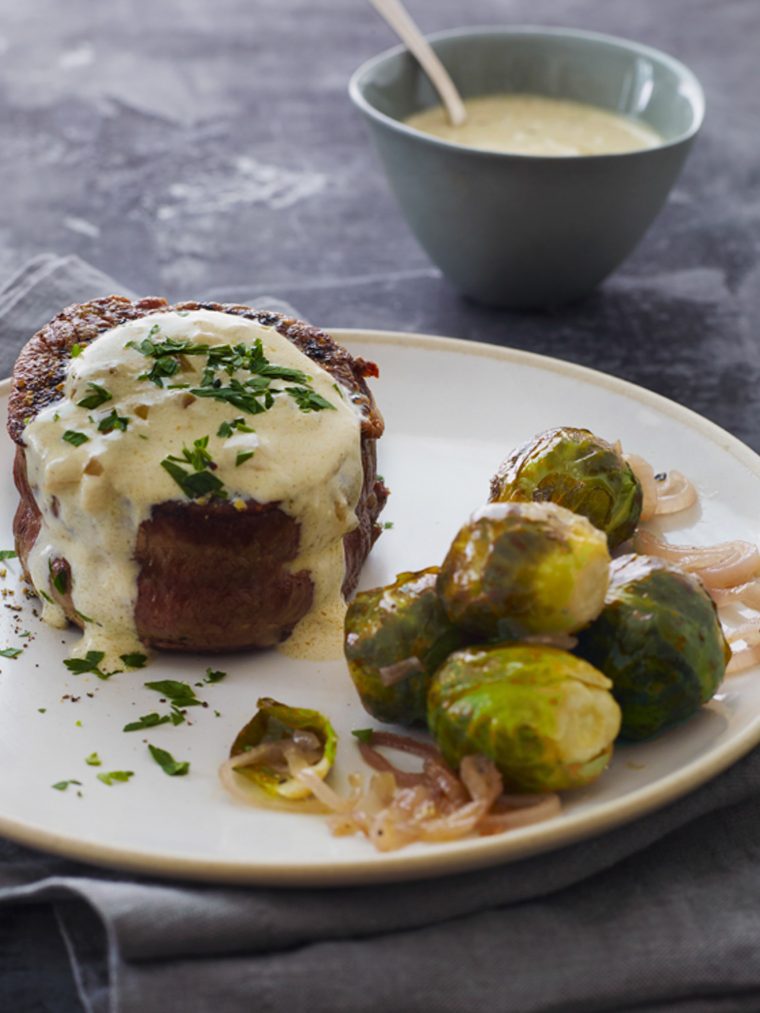
When I was twenty years old, I signed up to work as an au pair in Paris. I went there believing I’d be visiting museums and lingering in Parisian cafés as the children scampered about me in adorable berets, always ready and willing to take a nap when I needed a break. HA! I still laugh about that to this day. Instead, I was taking care of three mischievous little boys and a puppy, running errands, and ironing children’s clothes for hours on end.
But the job did have one special thing going for it: my host mother, Valérie, was a wonderful cook. When I think of her today, I still picture her standing at the kitchen table, crushing peppercorns with the back of a frying pan for her signature dish, steak au poivre—beef tenderloin fillet with a crunchy peppercorn crust and a rich Cognac sauce. Though I learned to make the dish while working in a French restaurant, this steak au poivre recipe always brings me back to Valérie’s kitchen.
“I made this for my husband on Valentine’s day and he said it was one of the best things I have ever cooked. Thank you!”
What You’ll Need To Make Steak au Poivre
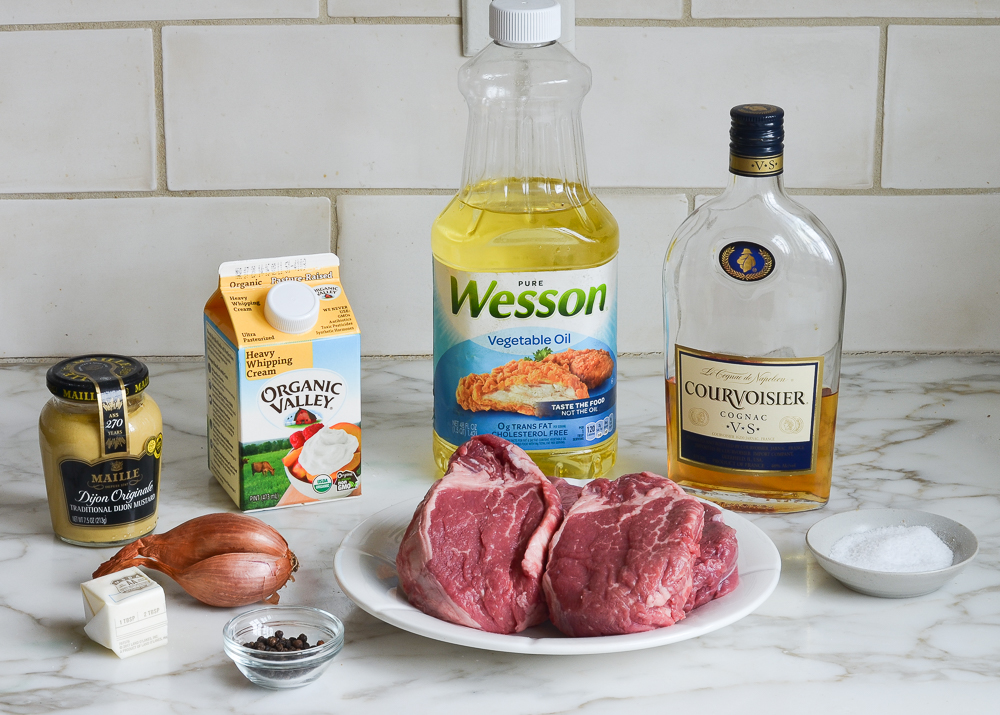
- Vegetable Oil: Used to sear the steaks, ensuring they develop a rich, golden-brown crust; this type of oil stands up to the high heat required for a perfect sear.
- Filet mignons: Cut from the beef tenderloin, this lean, buttery-soft steak pairs nicely with the bold, peppery crust and rich, creamy sauce. New York strip steaks are also a great option if you prefer a heartier, more flavorful cut.
- Kosher salt: Brings out the natural flavors of the steak and balances the seasonings. Its coarse texture makes it easier to sprinkle evenly over the meat.
- Whole peppercorns: Cracked by hand, black peppercorns create the bold, spicy crust that defines the dish. For a twist, you can also add green peppercorns, which are milder.
- Unsalted Butter: Used to cook the shallots, it adds richness and depth of flavor to the sauce.
- Shallots: Their mild, sweet onion flavor adds a layer of complexity to the sauce without overwhelming the taste of the steak.
- Cognac: Deglazes the pan, adding a complex, slightly sweet flavor that’s the foundation of the sauce. Feel free to substitute brandy if that’s what you have on hand.
- Heavy cream: The key to the au poivre sauce’s creamy texture, it balances the heat of the peppercorns and enriches the flavor.
- Dijon mustard: Adds tanginess and depth to the sauce.
- Jump to the printable recipe for precise measurements
Step-by-Step Instructions
Step 1: Sear the Steaks
To begin, seal the peppercorns inside a small plastic bag and place on a cutting board. Using a meat pounder, pound the peppercorns until they are coarsely crushed.
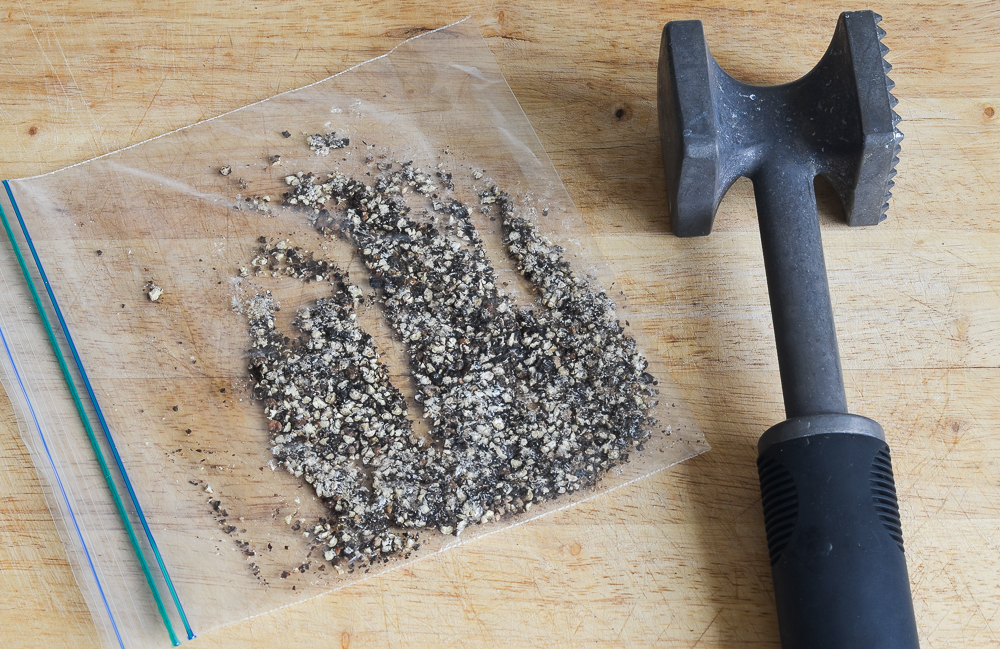
Pat the steaks dry and, if they are thick, gently press them down so that they are about 1-1/2 inches tall. Season the steaks all over with the crushed peppercorns and salt, pressing to make sure the seasoning adheres.
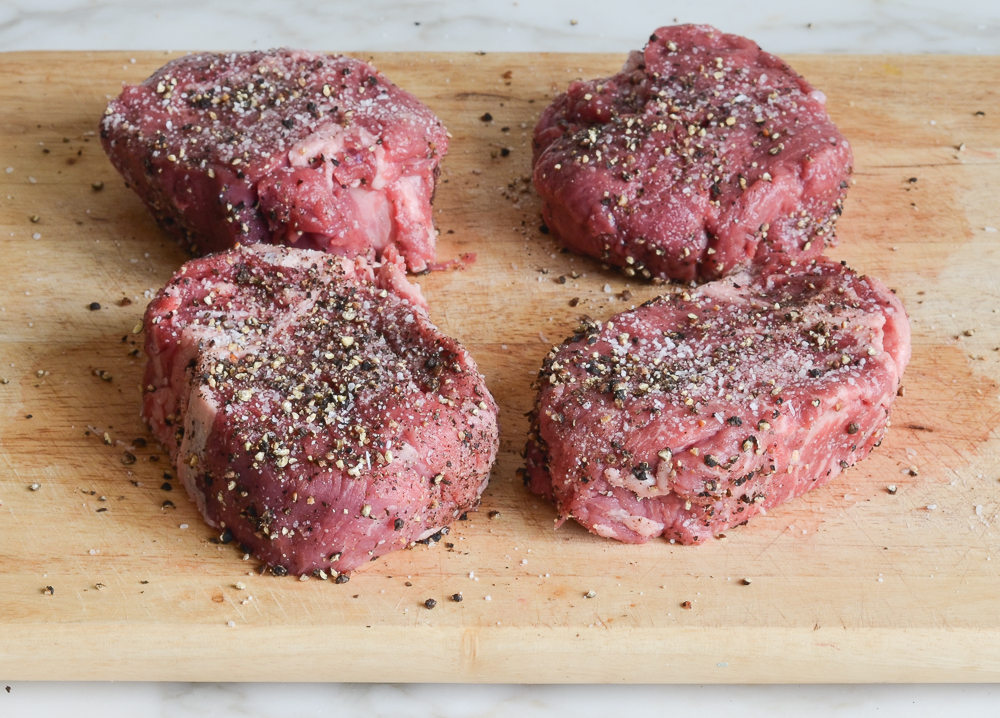
In a large stainless steel or cast iron skillet, heat the oil over medium-high heat. When the oil is hot and shimmering, add the steaks.
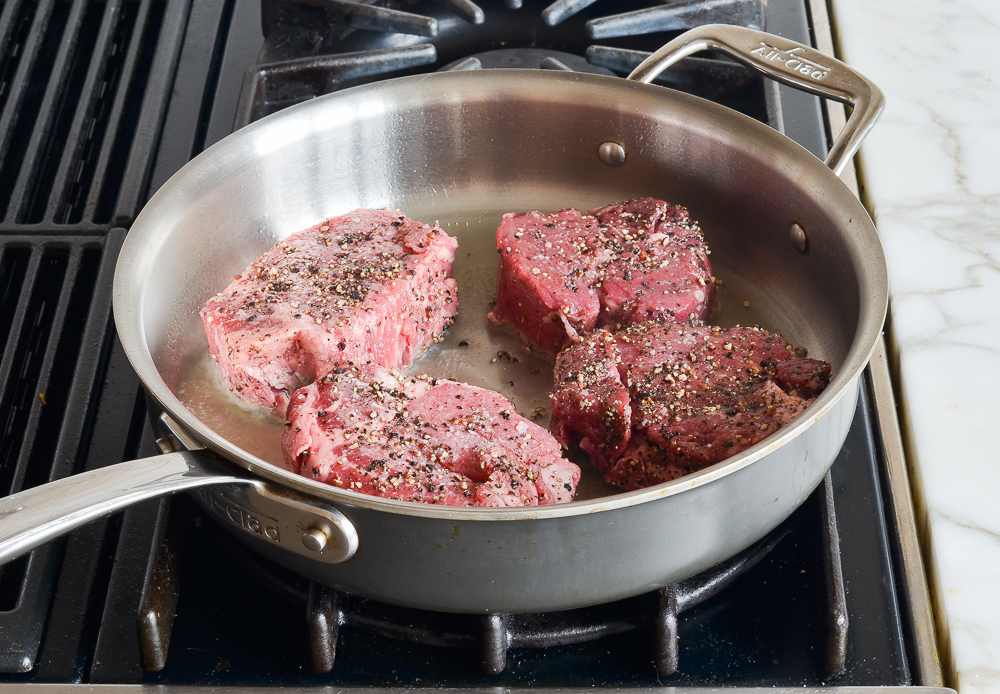
Cook about 4 minutes on each side, turning only once, for medium-rare (or about 5 minutes per side for medium). Transfer the steaks to a plate and tent with foil.
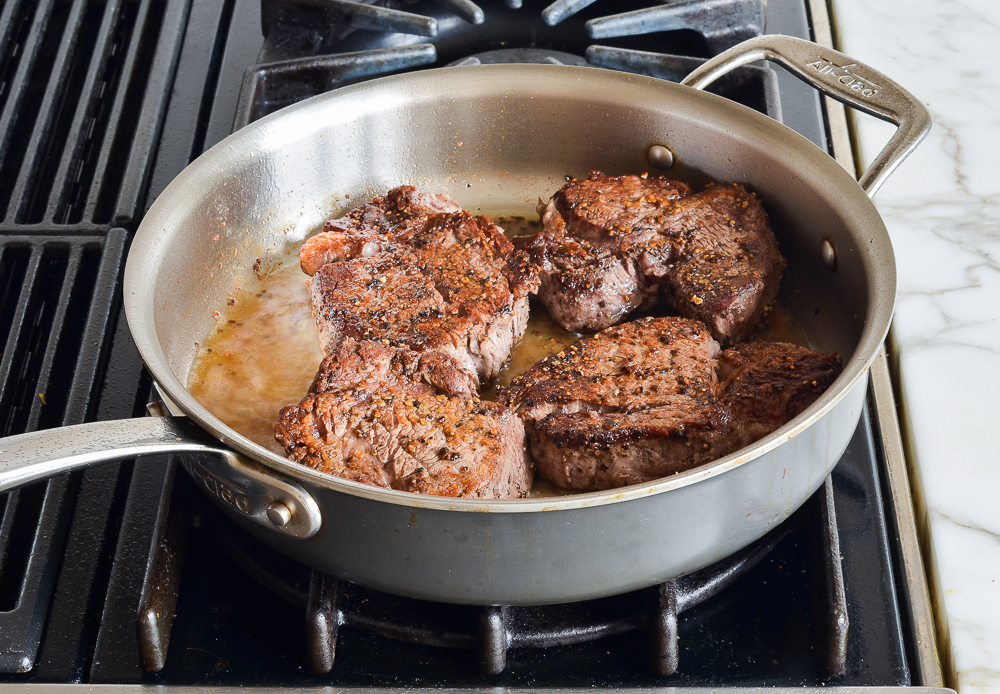
Step 2: Make the Pan Sauce
Pour off the excess fat from the pan but do not wipe clean. Lower the heat to medium-low and add the butter and shallots.
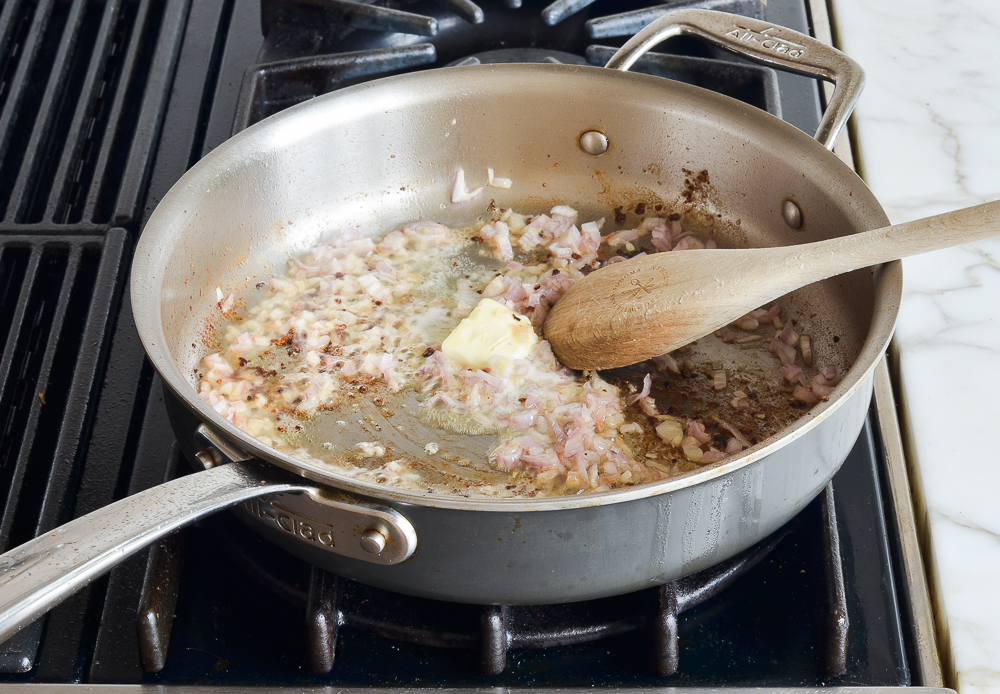
Cook, stirring constantly with a wooden spoon and scraping up the brown bits, until the shallots are golden brown and softened, 2 to 3 minutes.
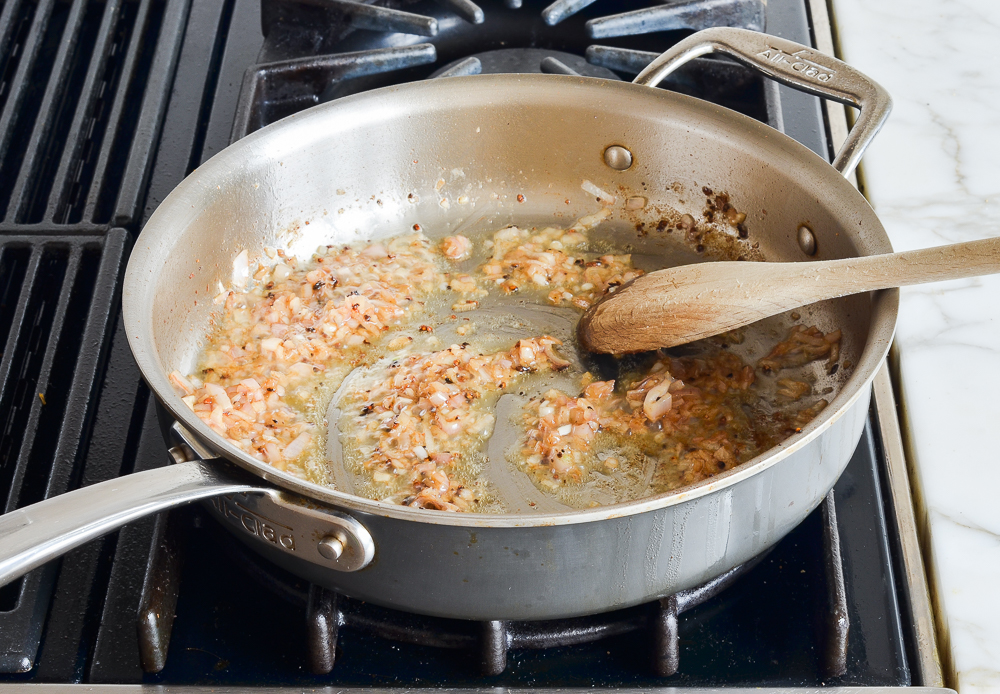
Carefully add the Cognac (it may flare up) and bring to a boil, stirring to scrape up the browned bits from the bottom of the pan. You can flambé the alcohol if you’d like, but it’s not necessary—simmering will burn it off just the same. Just be cautious: If you’re cooking over a gas flame, it’s easy for the Cognac to ignite unexpectedly when it hits the pan, which can be alarming, especially when the flames get a little too close to your cabinets!
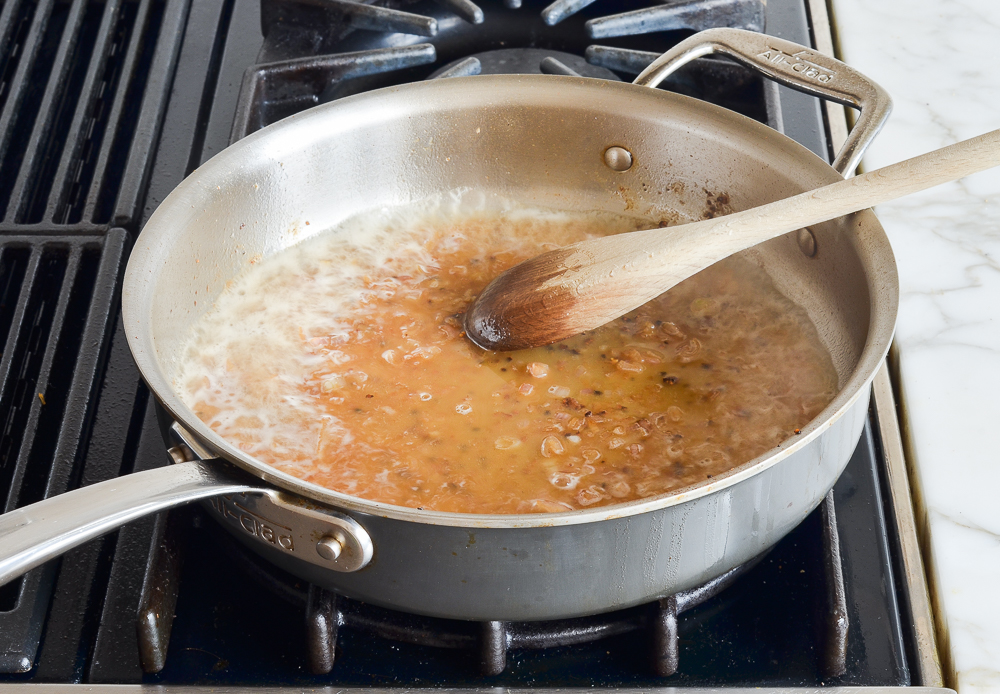
Cook until the liquid is reduced to a glaze and mostly absorbed by the shallots, a few minutes.
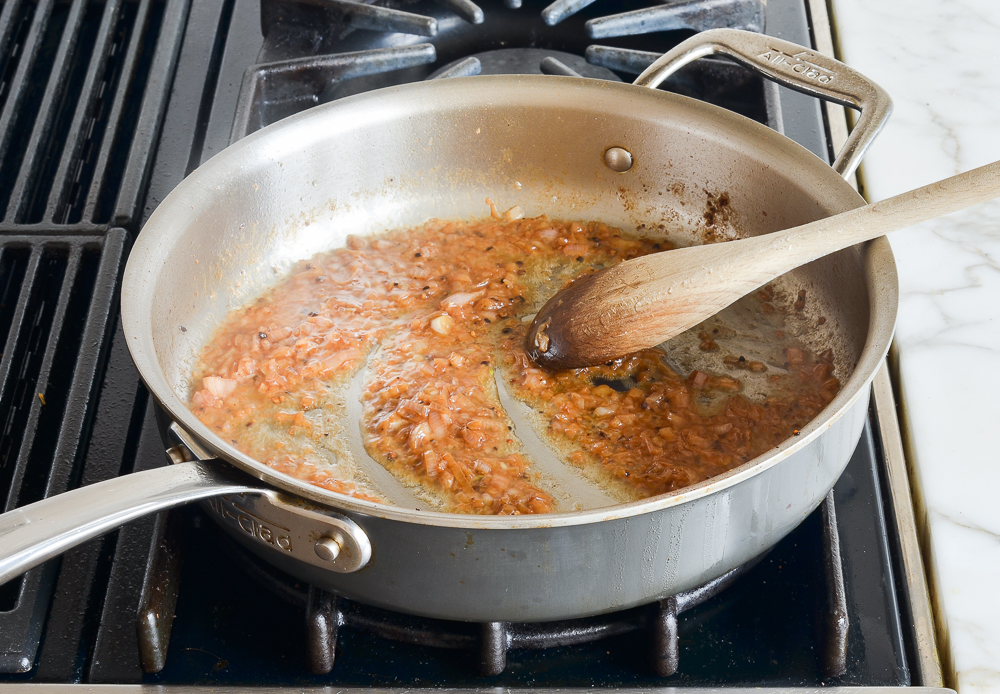
Add the cream and mustard and bring to a gentle boil.
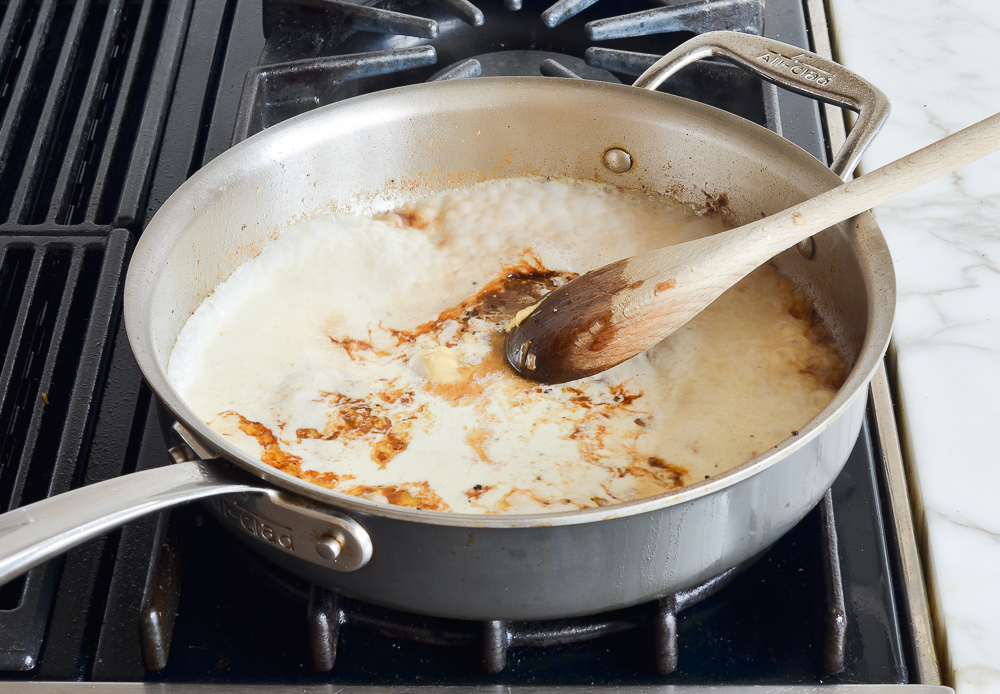
Simmer until thickened, about 3 minutes, and then stir in any meat juices that accumulated on the plate.
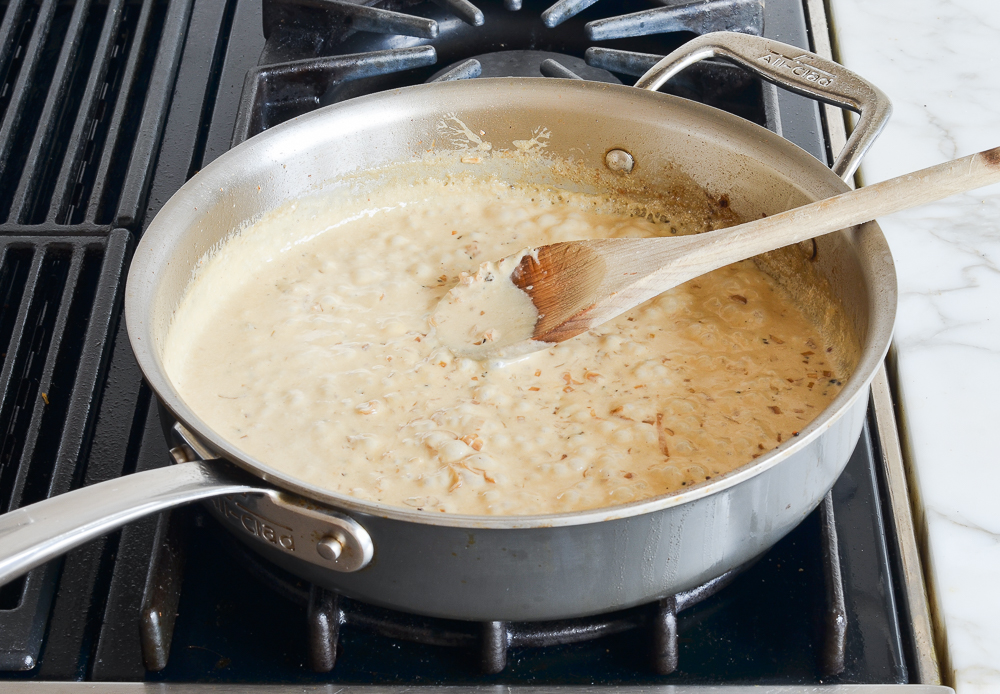
Transfer the steaks to plates and spoon the cream sauce over top. Pair steak au poivre with roasted potatoes and a simple green vegetable, like roasted asparagus, French green beans, or roasted Brussels sprouts.
Frequently Asked Questions
The key to achieving your preferred level of doneness is using a meat thermometer and understanding the correct internal temperatures: 120-125°F for rare, 130-135°F for medium-rare, 140-145°F for medium, 150-155°F for medium-well, and 160-165°F for well done. Remember to remove the steak from the heat a few degrees before it reaches the target temperature, as it will continue to cook while resting. Allowing the steak to rest for 5-10 minutes before serving also helps redistribute the juices, ensuring a moist and flavorful steak.
For cooking steak, I recommend cast iron or stainless steel skillets. Cast iron provides superior heat retention for an even sear, while stainless steel offers excellent heat transfer and is great for browning and making sauces. Both are perfect for getting that restaurant-quality sear that truly makes a great steak.

You May Also Like
Steak au Poivre
Master the art of steak au poivre—pan-seared filet mignon coated in cracked peppercorns, finished with a rich Cognac sauce.
Ingredients
- Four 6- to 8-ounce filet mignons
- 1 heaping teaspoon kosher salt
- 1 tablespoon whole peppercorns
- 1 tablespoon vegetable oil
- 2 tablespoons unsalted butter
- ⅓ cup finely chopped shallots, from 1 medium shallot
- ½ cup Cognac or other brandy
- ¾ cup heavy cream
- 1 teaspoon Dijon mustard
Instructions
- Pat the steaks dry and, if they are thick, gently press them down so that they are about 1½ inches thick. Season the steaks all over with the salt.
- Seal the peppercorns inside a small plastic bag and place on a cutting board. Using a meat mallet or the bottom of a frying pan, pound the peppercorns until they are coarsely crushed. Press the crushed pepper evenly onto both sides of the steaks.
- In a large stainless steel or cast iron skillet, heat the oil over medium-high heat. When the oil is hot and shimmering, add the steaks and cook about 4 minutes on each side, turning only once, for medium-rare (or about 5 minutes per side for medium). Transfer the steaks to a plate and tent with foil.
- Pour off the excess fat from the pan but do not wipe clean. Lower the heat to medium-low and add the butter and shallots. Cook, stirring constantly with a wooden spoon and scraping up the brown bits, until the shallots are golden brown and softened, 2 to 3 minutes. Carefully add the Cognac (it may ignite) and boil, again stirring to scrape up the brown bits, until the liquid is reduced to a glaze and mostly absorbed by the shallots, a few minutes. Add the cream and mustard and gently boil until thickened, about 3 minutes. Stir in any meat juices that accumulated on the plate. Transfer the steaks to plates and spoon the sauce over top.
Pair with
Nutrition Information
Powered by ![]()
- Serving size: 1 6-oz filet
- Calories: 721
- Fat: 55 g
- Saturated fat: 26 g
- Carbohydrates: 5 g
- Sugar: 2 g
- Fiber: 1 g
- Protein: 34 g
- Sodium: 587 mg
- Cholesterol: 217 mg
This website is written and produced for informational purposes only. I am not a certified nutritionist and the nutritional data on this site has not been evaluated or approved by a nutritionist or the Food and Drug Administration. Nutritional information is offered as a courtesy and should not be construed as a guarantee. The data is calculated through an online nutritional calculator, Edamam.com. Although I do my best to provide accurate nutritional information, these figures should be considered estimates only. Varying factors such as product types or brands purchased, natural fluctuations in fresh produce, and the way ingredients are processed change the effective nutritional information in any given recipe. Furthermore, different online calculators provide different results depending on their own nutrition fact sources and algorithms. To obtain the most accurate nutritional information in a given recipe, you should calculate the nutritional information with the actual ingredients used in your recipe, using your preferred nutrition calculator.
Gluten-Free Adaptable Note
To the best of my knowledge, all of the ingredients used in this recipe are gluten-free or widely available in gluten-free versions. There is hidden gluten in many foods; if you're following a gluten-free diet or cooking for someone with gluten allergies, always read the labels of your ingredients to verify that they are gluten-free.

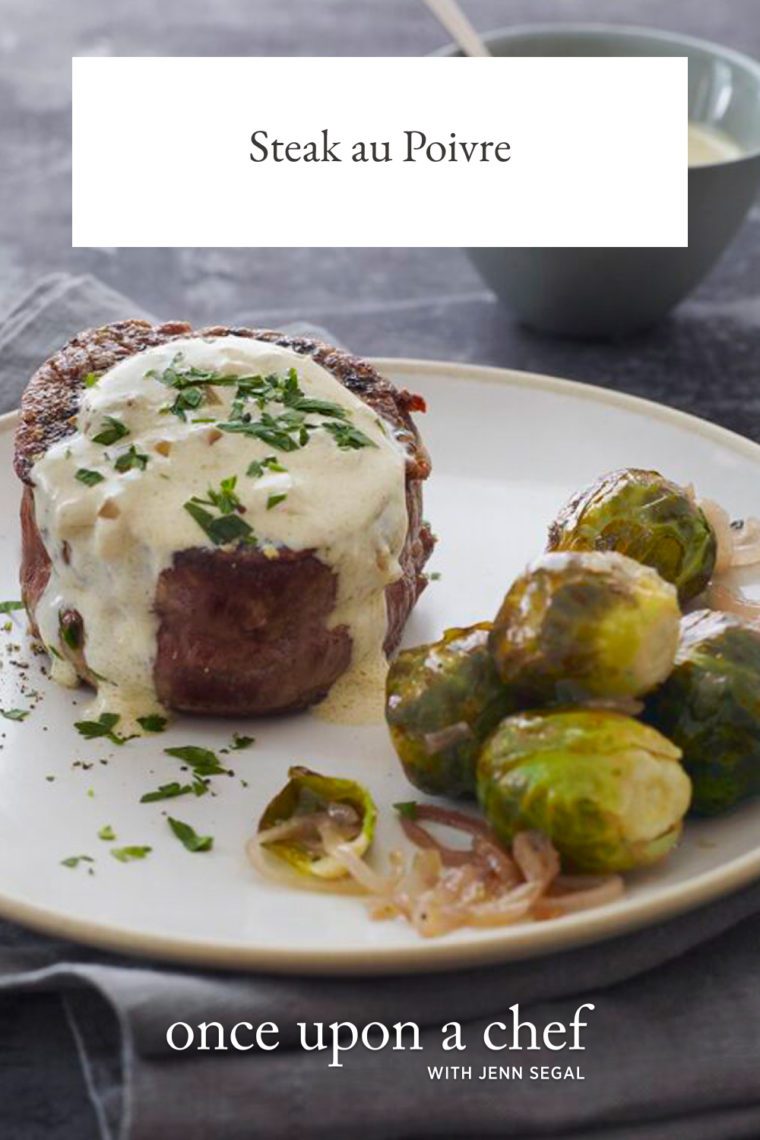
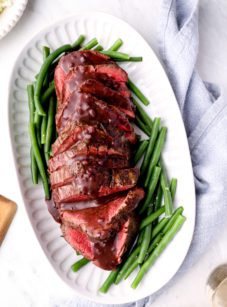
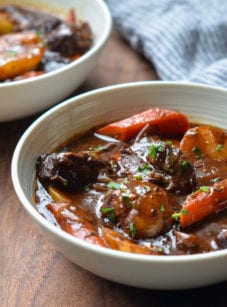


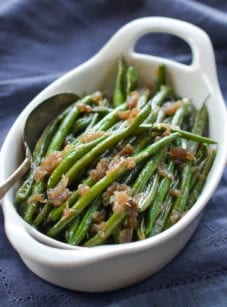
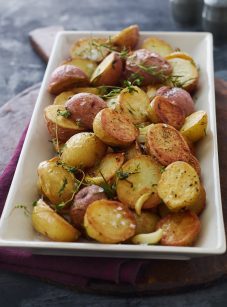
We made this the other night but grilled our filets! For the sauce, we added a little extra butter, per Jenn’s recommendation and….WOW. Unbelievable. The sauce was just as delicious cold the next day with leftover filet, per the family! Thanks for another weeknight winner! You are amazing.
I have not made any of your recipes BUT as a classically trained French chef myself I must congratulate you.
I am so tired of hearing the phrases ‘easy’ and ‘family friendly’. Normally such descriptions are due to short cuts being taken and the recipes are poor.
Your method and descriptions are perfect and you should be proud of putting together excellent recipes which will work perfectly.
Bravo!
Chef Paulus
Axat France
Thanks so much for your kind words!
Terrific recipe. I need to make 8 steaks.
Do you recommend I cook the steak in batches and double the sauce recipe? Thx!
Yes, I think that would be the way to go. Hope everyone enjoys!
This Steak Au Poivre is better than any similar steak in a restaurant. We are making it for the third time. It is so tasty and easy to make. We’d rather cook with you than go out to eat. I’ve easily made a hundred of your recipes…every one is outstanding. Thanks Jenn
💗
Amazing!! Made this for Valentine’s Day and it was delicious. Thank you for sharing your gifts and talents with us, Jenn!
Excellent! Made this last night for Christmas dinner, and it was a hit. Thank you for another wonderful recipe! Made other dishes from Once Upon a Chef for Christmas dinner: Potatoes Au Gratin (a family favorite) and Cheesecake with Berry Sauce (first time making and it was fantastic). Thank you for developing and sharing such wonderful recipes – I am so grateful!
💗
This was a lovely recipe I made for an anniversary dinner and the teens loved it too. It brought back memories from 30 years ago as an 18 year old, when I ate & drank my way thru France and Luxembourg for a month. Steak au Poivre or Sole Meuniere were my favorites! The simplicity of the French classics makes them timeless. Thank you for a wonderful recipe.
Can you share what Brandy you recommend? Thanks
Hi Bonnie, I generally use Courvoisier brander for this. 😊
Hi Jenn –
I’m a big fan, have both of your cookbooks and followed your blog early on. I refer all my friends to your website.
My husband and I are going to Washington DC three nights before heading down to Blackberry farm in Tennessee. What steakhouse would you recommend in DC?
Thanks!
Hi Carol, thanks for your nice words about the recipes, your support of the cookbooks, and spreading the word about the blog! In terms of steakhouses, I’d recommend either The Palm or The Capital Grille. Hope you enjoy wherever you go and have a great trip!
Perfect steaks everytime now that I found you. Ty
Soooo good and so easy! I made this yesterday for Valentine’s Day and the presentation/deliciousness value to work was off the charts! I had one very thick filet mignon so I halved it to make thinner steaks and halved the recipe, using half and half instead of heavy cream. I covered the steak with foil and put in a 180 degree oven on dinner plates to keep the steaks warm while finishing the sauce. It was perfect! Our only dilemma was whether to drink a sparkling wine or good cabernet with the meal!